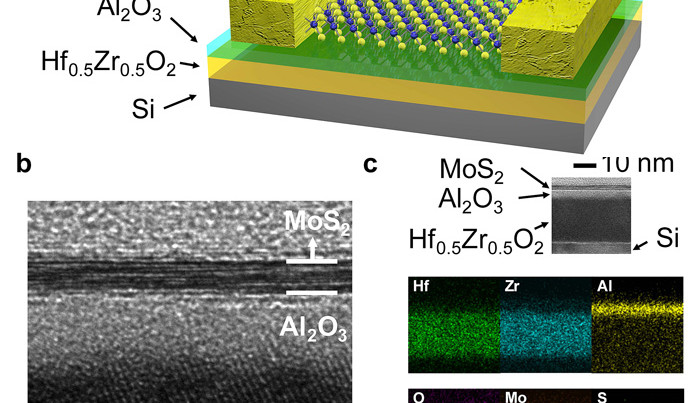Negative capacitance makes FETs more efficient
December 20, 2017
on
on

b) Transmission electron microscopy image of the new transistor structure
c) Detailed energy dispersive X-ray spectrometry mapping.
images courtesy Purdue University photo/Mengwei Si
Researchers from Purdue University were able to demonstrate experimentally how an effect called ‘negative capacitance’ makes a new transistor type more energy efficient. This proves a theory proposed in 2008 by a team at Purdue University.
The researchers used an extremely thin 2-D layer of molybdenum disulfide semiconductor material to create a channel close to the FET gate. Next they used the ferroelectric material hafnium zirconium to build a ‘negative capacitor’ in the gate.
The property of capacitance to store electrical charge is usually positive. By using ferroelectric materials in the FET gate structure however allows a negative capacitance. The energy required to switch the FET is thereby greatly reduced. Hafnium oxide is already used in modern FETs as a dielectric material to isolate the gate. This new FET design just replaces hafnium oxide with hafnium zirconium oxide.
FETs are widely employed as fast switching elements in digital circuits. They form the most basic element of data processing in most computer systems. It is important that when the FET is switched off is has the lowest possible leakage current. Conventional MOSFETs usually require an additional 60 mV gate voltage for every decade increase of drain current, a value referred to as the thermionic limit. Negative-capacitance FETs might not be subject to this fundamental limit so they should be able to switch using a much lower voltage thereby reducing power consumption.
The researchers used an extremely thin 2-D layer of molybdenum disulfide semiconductor material to create a channel close to the FET gate. Next they used the ferroelectric material hafnium zirconium to build a ‘negative capacitor’ in the gate.
The property of capacitance to store electrical charge is usually positive. By using ferroelectric materials in the FET gate structure however allows a negative capacitance. The energy required to switch the FET is thereby greatly reduced. Hafnium oxide is already used in modern FETs as a dielectric material to isolate the gate. This new FET design just replaces hafnium oxide with hafnium zirconium oxide.
FETs are widely employed as fast switching elements in digital circuits. They form the most basic element of data processing in most computer systems. It is important that when the FET is switched off is has the lowest possible leakage current. Conventional MOSFETs usually require an additional 60 mV gate voltage for every decade increase of drain current, a value referred to as the thermionic limit. Negative-capacitance FETs might not be subject to this fundamental limit so they should be able to switch using a much lower voltage thereby reducing power consumption.
Read full article
Hide full article


Discussion (1 comment)